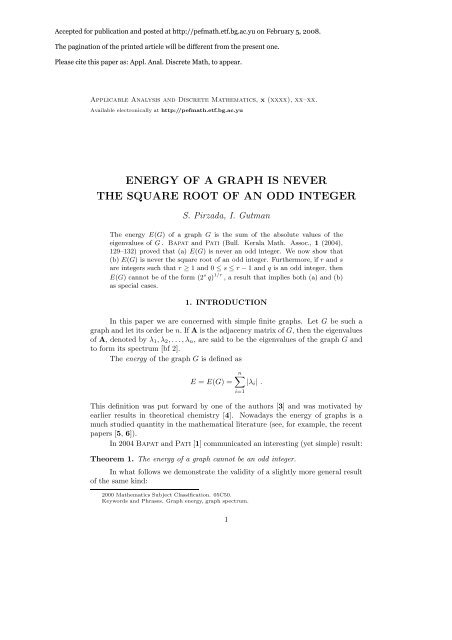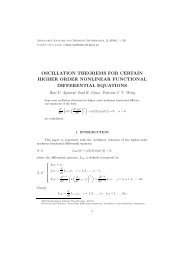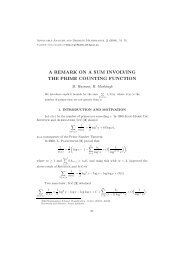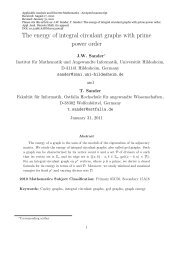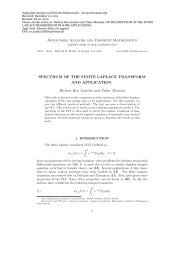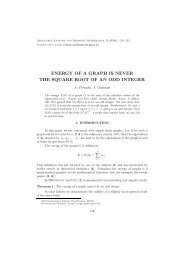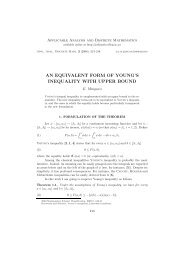energy of a graph is never the square root of an odd integer
energy of a graph is never the square root of an odd integer
energy of a graph is never the square root of an odd integer
You also want an ePaper? Increase the reach of your titles
YUMPU automatically turns print PDFs into web optimized ePapers that Google loves.
Accepted for publication <strong>an</strong>d posted at http://pefmath.etf.bg.ac.yu on February 5, 2008.The pagination <strong>of</strong> <strong>the</strong> printed article will be different from <strong>the</strong> present one.Please cite th<strong>is</strong> paper as: Appl. Anal. D<strong>is</strong>crete Math, to appear.Applicable Analys<strong>is</strong> <strong>an</strong>d D<strong>is</strong>crete Ma<strong>the</strong>matics, x (xxxx), xx–xx.Available electronically at http://pefmath.etf.bg.ac.yuENERGY OF A GRAPH IS NEVERTHE SQUARE ROOT OF AN ODD INTEGERS. Pirzada, I. Gutm<strong>an</strong>The <strong>energy</strong> E(G) <strong>of</strong> a <strong>graph</strong> G <strong>is</strong> <strong>the</strong> sum <strong>of</strong> <strong>the</strong> absolute values <strong>of</strong> <strong>the</strong>eigenvalues <strong>of</strong> G . Bapat <strong>an</strong>d Pati (Bull. Kerala Math. Assoc., 1 (2004),129–132) proved that (a) E(G) <strong>is</strong> <strong>never</strong> <strong>an</strong> <strong>odd</strong> <strong>integer</strong>. We now show that(b) E(G) <strong>is</strong> <strong>never</strong> <strong>the</strong> <strong>square</strong> <strong>root</strong> <strong>of</strong> <strong>an</strong> <strong>odd</strong> <strong>integer</strong>. Fur<strong>the</strong>rmore, if r <strong>an</strong>d sare <strong>integer</strong>s such that r ≥ 1 <strong>an</strong>d 0 ≤ s ≤ r − 1 <strong>an</strong>d q <strong>is</strong> <strong>an</strong> <strong>odd</strong> <strong>integer</strong>, <strong>the</strong>nE(G) c<strong>an</strong>not be <strong>of</strong> <strong>the</strong> form (2 s q) 1/r , a result that implies both (a) <strong>an</strong>d (b)as special cases.1. INTRODUCTIONIn th<strong>is</strong> paper we are concerned with simple finite <strong>graph</strong>s. Let G be such a<strong>graph</strong> <strong>an</strong>d let its order be n. If A <strong>is</strong> <strong>the</strong> adjacency matrix <strong>of</strong> G, <strong>the</strong>n <strong>the</strong> eigenvalues<strong>of</strong> A, denoted by λ 1 , λ 2 , . . .,λ n , are said to be <strong>the</strong> eigenvalues <strong>of</strong> <strong>the</strong> <strong>graph</strong> G <strong>an</strong>dto form its spectrum [bf 2].The <strong>energy</strong> <strong>of</strong> <strong>the</strong> <strong>graph</strong> G <strong>is</strong> defined asE = E(G) =n∑|λ i | .Th<strong>is</strong> definition was put forward by one <strong>of</strong> <strong>the</strong> authors [3] <strong>an</strong>d was motivated byearlier results in <strong>the</strong>oretical chem<strong>is</strong>try [4]. Nowadays <strong>the</strong> <strong>energy</strong> <strong>of</strong> <strong>graph</strong>s <strong>is</strong> amuch studied qu<strong>an</strong>tity in <strong>the</strong> ma<strong>the</strong>matical literature (see, for example, <strong>the</strong> recentpapers [5, 6]).In 2004 Bapat <strong>an</strong>d Pati [1] communicated <strong>an</strong> interesting (yet simple) result:Theorem 1. The <strong>energy</strong> <strong>of</strong> a <strong>graph</strong> c<strong>an</strong>not be <strong>an</strong> <strong>odd</strong> <strong>integer</strong>.In what follows we demonstrate <strong>the</strong> validity <strong>of</strong> a slightly more general result<strong>of</strong> <strong>the</strong> same kind:i=12000 Ma<strong>the</strong>matics Subject Classification. 05C50.Keywords <strong>an</strong>d Phrases. Graph <strong>energy</strong>, <strong>graph</strong> spectrum.1
2 S. Pirzada, I. Gutm<strong>an</strong>Theorem 2. The <strong>energy</strong> <strong>of</strong> a <strong>graph</strong> c<strong>an</strong>not be <strong>the</strong> <strong>square</strong> <strong>root</strong> <strong>of</strong> <strong>an</strong> <strong>odd</strong> <strong>integer</strong>.In order to prove Theorem 2 we need some preliminaries.2. PRELIMINARIESUsing <strong>the</strong> terminology <strong>an</strong>d notation from <strong>the</strong> book [2], we define two operationswith <strong>graph</strong>s.By V (G) <strong>an</strong>d E(G) are denoted <strong>the</strong> vertex <strong>an</strong>d edge sets, respectively, <strong>of</strong> <strong>the</strong><strong>graph</strong> G.Let G 1 <strong>an</strong>d G 2 be two <strong>graph</strong>s with d<strong>is</strong>joint vertex sets <strong>of</strong> orders n 1 <strong>an</strong>d n 2 ,respectively.The product <strong>of</strong> G 1 <strong>an</strong>d G 2 , denoted by G 1 × G 2 , <strong>is</strong> <strong>the</strong> <strong>graph</strong> with vertexset V (G 1 ) × V (G 2 ) such that two vertices (x 1 , x 2 ) ∈ V (G 1 × G 2 ) <strong>an</strong>d (y 1 , y 2 ) ∈V (G 1 × G 2 ) are adjacent if <strong>an</strong>d only if (x 1 , y 1 ) ∈ E(G 1 ) <strong>an</strong>d (x 2 , y 2 ) ∈ E(G 2 ).The sum <strong>of</strong> G 1 <strong>an</strong>d G 2 , denoted by G 1 + G 2 , <strong>is</strong> <strong>the</strong> <strong>graph</strong> with vertex setV (G 1 )×V (G 2 ) such that two vertices (x 1 , x 2 ) ∈ V (G 1 +G 2 ) <strong>an</strong>d (y 1 , y 2 ) ∈ V (G 1 +G 2 ) are adjacent if <strong>an</strong>d only if ei<strong>the</strong>r (x 1 , y 1 ) ∈ E(G 1 ) <strong>an</strong>d x 2 = y 2 or (x 2 , y 2 ) ∈E(G 2 ) <strong>an</strong>d x 1 = y 1 .The above specified two <strong>graph</strong> products have <strong>the</strong> following spectral properties(see [2], p. 70).Let λ (1)i , i = 1, . . .,n 1 , <strong>an</strong>d λ (2)j , j = 1, . . . , n 2 , be, respectively, <strong>the</strong> eigenvalues<strong>of</strong> <strong>the</strong> <strong>graph</strong>s G 1 <strong>an</strong>d G 2 .Lemma 1. The eigenvalues <strong>of</strong> G 1 × G 2 are λ (1)i λ (2)j , i = 1, . . .,n 1 ; j = 1, . . . , n 2 .Lemma 2. The eigenvalues <strong>of</strong> G 1 +G 2 are λ (1)i +λ (2)j , i = 1, . . .,n 1 ; j = 1, . . .,n 2 .The eigenvalues <strong>of</strong> a <strong>graph</strong> are zeros <strong>of</strong> <strong>the</strong> character<strong>is</strong>tic polynomial <strong>an</strong>d <strong>the</strong>character<strong>is</strong>tic polynomial <strong>is</strong> a monic polynomial with <strong>integer</strong> coefficients. Thereforewe have:Lemma 3. If <strong>an</strong> eigenvalue <strong>of</strong> a <strong>graph</strong> <strong>is</strong> a rational number, <strong>the</strong>n it <strong>is</strong> <strong>an</strong> <strong>integer</strong>.3. PROOF OF THEOREM 2Consider a <strong>graph</strong> G <strong>an</strong>d let λ 1 , λ 2 , . . . , λ m be its positive eigenvalues. Thenin view <strong>of</strong> <strong>the</strong> fact that <strong>the</strong> sum <strong>of</strong> all eigenvalues <strong>of</strong> <strong>an</strong>y <strong>graph</strong> <strong>is</strong> equal to zeroE(G) = 2m∑λ i .i=1Denote λ 1 + λ 2 + · · · + λ m by λ. By Lemma 1 λ <strong>is</strong> <strong>an</strong> eigenvalue <strong>of</strong> some <strong>graph</strong> H<strong>is</strong>omorphic to <strong>the</strong> sum <strong>of</strong> m d<strong>is</strong>joint copies <strong>of</strong> <strong>the</strong> <strong>graph</strong> G. By Lemma 2 λ 2 <strong>is</strong> <strong>an</strong>eigenvalues <strong>of</strong> <strong>the</strong> product <strong>of</strong> two d<strong>is</strong>joint copies <strong>of</strong> <strong>the</strong> <strong>graph</strong> H.
Energy <strong>of</strong> a <strong>graph</strong> <strong>is</strong> <strong>never</strong> <strong>the</strong> <strong>square</strong> <strong>root</strong> <strong>of</strong> <strong>an</strong> <strong>odd</strong> <strong>integer</strong> 3Suppose now that E(G) = √ q, where q <strong>is</strong> some <strong>integer</strong>. Then 2 λ = √ q, i.e.,λ 2 = q/4. If q would be <strong>an</strong> <strong>odd</strong> <strong>integer</strong>, <strong>the</strong>n q/4 would be a nonintegral rationalnumber in contradiction to Lemma 3.Theorem 2 follows.□We have <strong>an</strong> immediate extension <strong>of</strong> Theorem 2:Observation. The <strong>energy</strong> <strong>of</strong> a <strong>graph</strong> c<strong>an</strong>not be <strong>the</strong> <strong>square</strong> <strong>root</strong> <strong>of</strong> <strong>the</strong> double <strong>of</strong> <strong>an</strong><strong>odd</strong> <strong>integer</strong>.However, th<strong>is</strong> observation <strong>is</strong> just a special case <strong>of</strong> a somewhat more generalresult.4. GENERALIZING THEOREM 2Let H be <strong>the</strong> same <strong>graph</strong> as in <strong>the</strong> preceding section. Thus λ <strong>an</strong> eigenvalue<strong>of</strong> H. Let H ∗ be <strong>the</strong> product <strong>of</strong> r d<strong>is</strong>joint copies <strong>of</strong> H. Then by Lemma 2 λ r <strong>is</strong> <strong>an</strong>eigenvalue H ∗ .Suppose now that E(G) = q 1/r , where q <strong>is</strong> some <strong>integer</strong>. Then 2 λ = q 1/r ,i.e., λ r = q/2 r . If q would not be div<strong>is</strong>ible by 2 r , <strong>the</strong>n λ r would be a nonintegralrational number in contradiction to Lemma 3. Therefore we have:Theorem 3. Let r <strong>an</strong>d s be <strong>integer</strong>s such that r ≥ 1 <strong>an</strong>d 0 ≤ s ≤ r − 1 <strong>an</strong>d q be<strong>an</strong> <strong>odd</strong> <strong>integer</strong>. Then E(G) c<strong>an</strong>not be <strong>of</strong> <strong>the</strong> form (2 s q) 1/r .For r = 1 <strong>an</strong>d s = 0 Theorem 3 reduces to Theorem 1. For r = 2 <strong>an</strong>d s = 0Theorem 3 reduces to Theorem 2. The Observation pertains to r = 2 <strong>an</strong>d s = 1.REFERENCES1. R. B. Bapat, S. Pati: Energy <strong>of</strong> a <strong>graph</strong> <strong>is</strong> <strong>never</strong> <strong>an</strong> <strong>odd</strong> <strong>integer</strong>. Bull. Kerala Math.Assoc., 1 (2004), 129–132.2. D. Cvetković, M. Doob, H. Sachs: Spectra <strong>of</strong> Graphs – Theory <strong>an</strong>d Application.Academic Press, New York, 1980; 2nd rev<strong>is</strong>ed ed.: Barth, Heidelberg, 1995.3. I. Gutm<strong>an</strong>: The <strong>energy</strong> <strong>of</strong> a <strong>graph</strong>. Ber. Math. Stat<strong>is</strong>t. Sekt. Forshungsz. Graz, 103(1978), 1–22.4. I. Gutm<strong>an</strong>, O. E. Pol<strong>an</strong>sky: Ma<strong>the</strong>matical Concepts in Org<strong>an</strong>ic Chem<strong>is</strong>try. Springer–Verlag, Berlin, 1986.5. H. Hua, M. W<strong>an</strong>g: Unicyclic <strong>graph</strong>s with given number <strong>of</strong> pendent vertices <strong>an</strong>d minimal<strong>energy</strong>. Lin. Algebra Appl., 426 (2007), 478–489.6. V. Nikiforov: Graphs <strong>an</strong>d matrices with maximal <strong>energy</strong>. J. Math. Anal. Appl., 327(2007) 735–738.
4 S. Pirzada, I. Gutm<strong>an</strong>Department <strong>of</strong> Ma<strong>the</strong>matics, (Received October 6, 2007)University <strong>of</strong> Kashmir,Srinagar,IndiaE-mail: sdpirzada@yahoo.co.inFaculty <strong>of</strong> Science,University <strong>of</strong> Kragujevac,Kragujevac,SerbiaE-mail: gutm<strong>an</strong>@kg.ac.yu


